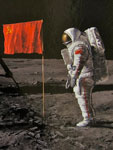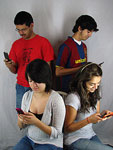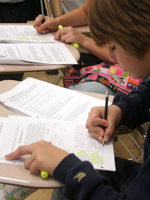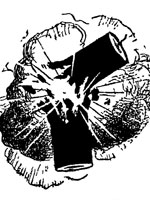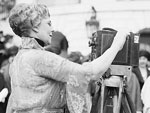It is difficult to step into the minds of our students. As teachers, we are frequently seeking feedback from students and looking for those signals that let us know they understand. It is challenging to figure out both when students don’t understand something and what students don’t understand. Fortunately, much research has gone into this dilemma and we know that we must go beyond the simple tasks of checking for understanding and clarifying confusion. We must offer ample opportunity for students to explain their reasoning and foster metacognition. New technology, backchannel discussion, is making students’ thinking more visible to us teachers.
What is It?
Backchannel communication is simply the communication that occurs simultaneously, but secondarily to instruction. For example, it could be the text messages students send to their classmates about how boring U.S. History class is. These secondary conversations occur in any meeting, and one could easily construe these conversations as disruptive. For the purposes of education, we want to formalize this backchannel chatter and give it a legitimate use in the classroom. This may differ from classroom to classroom, but essentially, students would sign in to a site from their wireless device or computer, post questions, reply to posts, and engage in a secondary conversation to the one occurring at the front of the room. Teachers can display this as a live feed on a LCD projector during class or can simply refer to it on their own device while teaching. In addition, teachers could post questions to this “chat group” to begin conversations prior to class and have them continue after class. Used effectively, a backchannel means extending the reach of class.
Use in the Classroom
The first step in setting up a backchannel is to decide what site you would like to use and set up an account. Your best bet is to explore a variety of backchannel-friendly tools (Twitter, TodaysMeet, TinyChat, Chatzy, Wallwisher, Edmodo) and decide what best suits your needs. The second step is to make your chat room known to your students and accessible. Decide if you want the bulk of the conversation to take place during class or outside class time. In my classroom, I prefer instantaneous feedback. I have a LCD projector dedicated to displaying the running backchannel conversation. (By the way, LCD projectors have really come down in price, so you may be able to dedicate one to this purpose.) I like being able to refer to the screen to readily adapt my teaching or answer questions as we go. If I ever feel the conversation is visually distracting, I can simply turn off the LCD, but still allow students to post their comments.
Having a running backchannel allows more “voices” to be heard as students type or text their thoughts.
In an effort to make students’ thinking visible, I am committed to fostering dialogue between students so that I as the teacher can better guide them. Having a running backchannel allows more “voices” to be heard as students type or text their thoughts. In a classroom conversation, I first ask an open-ended question; I then allow a few students to voice their responses aloud. Next, I turn students loose to discuss the question at hand with their group and explain their thinking. While these group discussions are taking place, students are simultaneously asked to text or type their thinking behind their answers to our backchannel feed. Students are doing the majority of the talking in this environment, and on top of that, more students are able to participate through the backchannel than would be able to participate in a normal class discussion. Students whom I find typically afraid to speak up in class find a voice for their thinking in the backchannel. As our class progresses, I refer to the backchannel discussion and use it as an opportunity to praise good thinking and validate those risk-taking students who acknowledged confusion.
In a more formal use of backchannel communication, try using it during a fishbowl discussion. In a fishbowl discussion, an outer circle of students act as quiet observers and an inner circle of students discuss. The outer circle could use a projected backchannel to fact-check, ask follow-up questions, and provide instant feedback to the speakers in the inner circle. With the backchannel conversation visible to the inner circle, adjustments can be made to the conversation in real time.
Have you ever run out of time before answering students “burning questions?" Another practical use of backchannel communication is allowing students to post questions during class that you as the teacher can come back to and answer after class. Students would need to know to log in to the backchannel site later to see their questions answered or to ask any new questions. If it is not feasible to have students log in at home, simply opening the backchannel conversation from yesterday's class allows you to pick up where you left off.
It is important that you decide ahead of time how you intend to use a backchannel. Will there be extra credit associated? Participation points? Or will your students understand the utility of the backchannel to bolster their understanding without extrinsic motivators? Are you dedicated to its use? If you do not pause to use it during class or follow up on student comments after class, students will not take the backchannel seriously.
Drawbacks
Make students aware of their digital footprint, and wary of putting anything into writing that is inappropriate.
The same things that make a backchannel conversation productive can also make it problematic. On one hand, a backchannel opens the door for timid students to participate or confused students to ask questions if they can remain anonymous. However, I lean in the other direction towards requiring student accountability, and require my students to post their class ID (a number only I and they know, not a sensitive number) before comments. Even after explicitly instructing students on the proper use of the backchannel, without some system of accountability I find the system too susceptible to the "comment smoke bomb" (an inappropriate comment made for distraction). Since I like to project the backchannel conversation, it is even more susceptible to student abuse; like anything new and exciting in your class, be prepared to shut it down if it's abused. Also, make students aware of their digital footprint, and wary of putting anything into writing that is inappropriate.
The other important issue is the use of cell phones in your classroom and your school policy on cell phones. While a backchannel conversation is easy to have in a computer lab where all students are at a computer, it is a bit trickier in a classroom. Students need access to a cell phone or other wireless-enabled device. You should make students aware that participation in a backchannel discussion may involve text message use and if they are unsure of their allotted texts to abstain from the activity (my experience is that every student with a cell phone is keenly aware of their text message allotment and this is a non-issue). As for breaking school cell phone policy, my feelings are as long as students are using cell phones for educational purposes, I can justify breaking the rules in my mind and hopefully in the mind of my principal.
In spite of its drawbacks, the possibilities of this background conversation are immense. While clickers offer us the ability to instantly check for understanding, they do not show us how students arrived at a given answer. Backchannel conversations, however, do allow us to see student thinking and adjust instruction accordingly.

